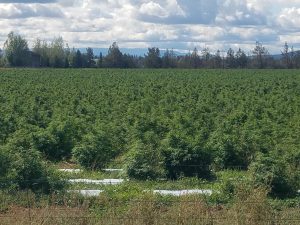
Four weeks after a hailstorm in Central Oregon wreaked havoc on roughly 500 acres of hemp, farmers say the area’s crop may not be a total loss.
Some of the damaged plants in one of the nation’s most heavily planted hemp areas have greened up and sprouted new leaves and flowers, said Deschutes County Farm Bureau President Matt Cyrus, who predicted just after the storm that the losses could total $25 million.
The final damage won’t be known until harvest begins about a month from now.
But it will likely be less than the original $25 million prediction, said Cyrus, who also operates Triple C Farms, a hemp farm near the town of Sisters.
“Some of the fields that I thought were going be a complete loss are actually fairly green at the moment. It’s just of function of how well they recover on the bud side,” Cyrus said.
Barrett Dash, who manages a hemp farm on the storm’s periphery, said the question now is whether the hemp survivors have enough time to develop before the weather cools.
“It’s not going to be a full recovery for everyone, unfortunately,” said Dash, manager of Dome Grown Produce and Hemp Farm outside Redmond.
Hemp showing its resiliency
Wesley Ray, co-founder of Combined Hemp, a farm in Bend, saw damage on his 35 acres of hemp fields.
Some plants are still damaged, he told Hemp Industry Daily, “but, for the most part, we’re back.”
Ray attributed his crop’s resiliency to well-timed fertilization about a week before the storm. Applying less nitrogen and more phosphorus and potassium in advance of the storm helped, he said.
But Ray is not ready to consider the year a success until his harvest is in.
“We see a storm roll in, and I get PTSD,” he said.
Crop insurance needed
The U.S. Department of Agriculture’s August announcement that it will provide Whole Farm Revenue Insurance to hemp farmers for the 2020 season was a welcome change, though it won’t help with the damage that’s already done.
And whether it’s government-backed or not, crop insurance is still costly for farmers, Cyrus added.
“Certainly insurance would help, but it’s also a function of cost,” he said. “Is it more cost effective to buy insurance on a regular basis or to just make the assumption that every 10 or 20 years you’re going to have crop failure?”
Dash hopes that hemp insurance will be tailored to its many uses, with high-value flower products being covered differently than lower-value fiber varieties.
“One size doesn’t fit all,” he said.
Laura Drotleff can be reached at [email protected]

